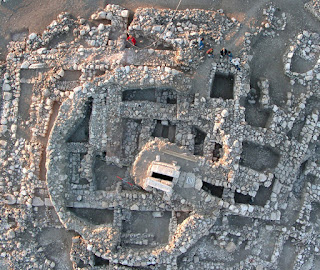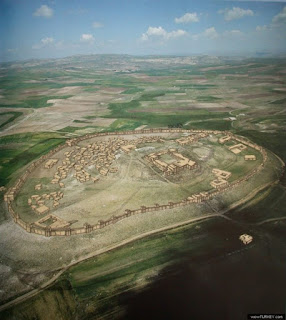Pisidia Bölgesi kentlerinden olan Ariassos, Antalya’nın 50 kilometre kuzeyinde Antalya kıyısını Anadolu Patosu'na bağlayan boğaz olan 924 metre yükseklikteki Çubukbeli’nin batısında, Akkoç Köyü'ne 1 kmilometre mesafede bulunmaktadır. Kentin resmi kuruluş yılı Manlius Vulso’nun seferi ve Apameia Barışı’yla bağlantılı olarak M.Ö. 189/188 yılıdır. Kent M.Ö. I. yüzyıldan Gallienus Dönemi’ne (253-267) kadar sikke basımına devam etmiştir. Hierokles tarafından kent, Geç Antik Dönem’de Pamphylia Eyaleti'nde gösterilmektedir. 12'nci yüzyıla kadar Notitia Episcopatum’da Pamphylia II Bölgesi’nin piskoposluğu olarak adlandırılmaktadır.
Diğer Pisidya kentleri ile birlik içerisinde olan Ariassos, Roma Dönemi’nde yollarının inşa edildiği bir geçit olarak yer almaktaydı.Bizans Dönemi'nden sonra kentte yaşam sona ermiştir. Ariassos kent planı incelendiğinde, doğudan batıya doğru ilk önce bir nekropol alanı, şehir surlarının güney köşesi ve sivil yapılar, şehir kapısı, kapıdan batıya doğru uzanan olası bir sütunlu cadde, bu caddenin kuzey tarafında esas kent yerleşimi, batısında yine bir nekropol alanı yer almaktadır. Kent doğu-batı doğrultusunda uzanan bu caddeye paralel olarak kuzey yamaçta oluşturulan teraslar üzerine yerleştirilmiştir. En önemli yapıları hemen hemen tam olarak ayakta duran şehir kapısı, mozole tipi mezar yapıları, şehir surları, Roma Yolu, suyolu, Nymphaion, Bouleuterion, oldukça yıkılmış bir bölümü kaybolmuş Gymnasion, hamam ve tiyatro yapılarıdır. Ariassos Kenti'ne girilen vadinin başlangıcında kentin en görkemli kalıntısı olan anıtsal giriş kapısı yükselir. Üç kemerli şehir kapısının Severus Alexander zamanında kullanılmakta olduğu anlaşılmaktadır. Ayrıca şehir kapısı ile çeşme binası arasında var olduğu kabul edilen sütunlu cadde üzerinde iki, kentin kuzeybatı bölümünde ise bir adet olmak üzere üç adet küçük kilise binası tespit edilmiştir. Kentin batı yamacında bugünkü Akkoç Köyü yolunu keserek inen Antik Roma Yolu kalıntısı mevcuttur. Düzgün döşenmiş iri bloklarla yapılmıştır. Bu yol, Termessos tarafından Ariassos’un batı kapısına gelen yoldur. Ariassos’un şehir kapısından sonra en göz alıcı yapıları anıtsal mezarlardır. Şehir yerleşimi ile bütünleşmiş olarak doğu ve batı tarafta iki nekropol alanı bulunmaktadır. Batı nekropolünün kuzey tarafında 9 tane mozole tipi mezar bulunmaktadır. Bunlar iki krepisli stylobat üzerine oturmuş ortostatlı bir podyum üzerine çift tonoz örtülüdür. Anteler arasındaki 6 merdivenle lahitin bulunduğu odalara çıkılır. Batı nekropolünde dörtgen planlı bir veya iki basamaklı platform üzerine oturmuş doğrudan girişli kırk adet daha basit yapılı mezar binası daha tespit edilmiştir. Doğu nekropolünde ise dokuz adet mezar yapısı karşımıza çıkar. Bunların dışında kireç taşından yapılmış, yanları tabula ansatalı, dar yüzleri Pisidia tipi kalkanlı lahitler ve doğrudan kayaya oyulmuş basit gömü şekilleri de kullanılmıştır.





Pisidia Area Ariassos within the city, 50 kilometers north of Antalya coast of Antalya, the Anatolia Patou 's 924 meters in height, which connects the throat Çubuk Passage to the west, 1 kmilometr Akkoç from the village. In connection with the expedition of the city's official foundation year Manlius Vulso and Apameia Peace I BC. It is the year 189/188. Kent BC He continued to print coins from the 1st century to the Gallienus Period (253-267). Hierokles city by the Late Antiquity from Pamphylia State 'is to be shown. Until the 12th century Notitia to my episcopate atIt is called the diocese of Pamphylia II Region .
Together with other Pisidian cities, Ariassos was located as a gateway where roads were built during the Roman Period . Life ended in the city after the Byzantine Period . When the Ariassos city plan is analyzed, first a necropolis area from the east to the west, the south corner of the city walls and civil buildings, the city gate, a possible columnar street extending from the gate to the west, the main city settlement on the north side of this street, and a necropolis area to the west. The city was placed on terraces formed on the north slope in parallel with this street extending in the east-west direction. The most important structures are almost completely standing city gate, mausoleum-type tomb structures, city walls, Roman Road, waterway, Nymphaion, Bouleuterion, Gymnasion, baths and theater structures, which have been destroyed in a rather destroyed part. The monumental entrance gate, the most magnificent remnant of the city, rises at the beginning of the valley, which is entered into the city of Ariassos. It is understood that the three-arched city gate was used during the time of Severus Alexander . In addition, three small church buildings were identified on the street with columns, which is accepted to exist between the city gate and the fountain building, and one in the northwestern part of the city. On the western slope of the city, there is the ruins of the Ancient Roman Road, which descends by cutting the road of Akkoç Village today . It was built with large blocks that were properly laid. This road is the road to the west gate of Ariassos by Termessos. The most spectacular buildings of Ariassos after the city gate are monumental tombs. Integrated with the city settlement, there are two necropolis areas on the east and west sides. There are 9 mausoleum-type tombs on the north side of the western necropolis. These are covered with double vaults on an orthostated podium seated on two crepe stylobats. You can go to the rooms where the sarcophagus is located by 6 stairs between the anteles. In the western necropolis, 40 more simple grave buildings with direct access were found, sitting on a one or two-step platform with a rectangular plan. In the eastern necropolis, we see nine grave structures. Apart from these, the sarcophagus made of limestone, the sides are made of tabular enamels, the narrow faces of the Pisidia-type shields and simple burials carved directly into the rock are used.

































































